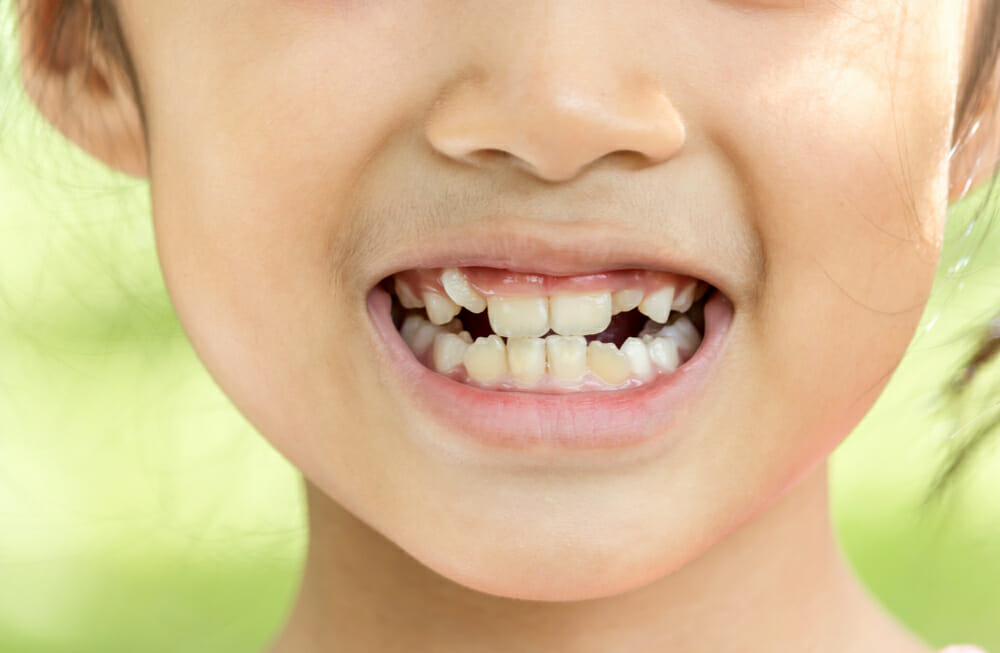Your children mean everything to you, and keeping them healthy and happy is important. It’s no wonder, then, that dental health plays a big role. All too often, however, children develop what is known as malocclusion, a misalignment of the jaw or teeth, which can cause problems now and in the future.
Whether your child suffers from an overbite, underbite, an uneven bite, or other misalignments, knowing what to do now can help avoid long-term effects. Many factors can cause malocclusion in children, and finding the right solution can make all the difference.
What Is Malocclusion in Children?
Malocclusion in children involves some level of misalignment, where the teeth can become crowded or crooked. This misalignment can alter your child’s bite, affecting the line-up of the upper and lower teeth.
When teeth don’t align properly, it can affect your children’s ability to speak and eat and also lead to dental problems. It can also make them self-conscious to the point they avoid social interactions.
What Are the Causes and Signs of Malocclusion in Children?
Malocclusion in children can have a variety of causes, both genetic and environmental.
If your child’s jaw is small, teeth can grow in crowded or crooked. If too much space exists inside the mouth, however, teeth can drift out of their designated spaces.
Other causes of malocclusion include:
- Bottle or pacifier extended use
- Thumb-sucking, especially if done after the age of five
- An inherited family trait, due to the shape and size of teeth, jaws, and face
- Small spacing between baby teeth, affecting permanent teeth when they come in (which may be larger and need more room)
- Loss of baby teeth early, late, or as a result of an accident
- Injury to the jaw
Signs of malocclusion in children include:
- Crowded teeth
- Oversized teeth
- Misplaced teeth
- Shifting jaws or jaws that make sounds
Bite issues are also a sign of malocclusion in children, including:
- Overbite, which may be called buck teeth
- Underbite (lower teeth protrude forward of upper front teeth)
- Open bite (failure of front teeth to meet when jaw closes)
- Crossbite (upper teeth sit behind the lower teeth)
Malocclusion can cause several different problems for children. The symptoms include:
- Difficulties chewing or biting
- Speech difficulties, including lisping
- Teeth grinding
- Increasing jaw pain
- Sensitive and unhealthy gums (gum disease)
- Mouth breathing
- Tooth decay (crooked or crowded teeth are harder to clean)
- Jaw joint issues
- Biting of cheek, lip, and tongue areas
Additional signs and symptoms may occur as well, so regular cleanings and dental exams can help identify an issue before it becomes a serious problem.
What Is the Treatment for Malocclusion in Children?
Unless your dentist offers extended services, most likely, your child will be referred to an orthodontist for evaluation and eventual treatment. Orthodontists focus on dental irregularities such as these.
The treatments for malocclusion differ depending upon your child’s age, signs, severity, and overall health. Any of the following may be recommended based on your child’s particular circumstances.
- Removal of baby teeth: Due to the common issue of mouth crowding in children, baby teeth can be removed to prepare room for permanent teeth to come in properly.
- Fixed mouth appliance: Braces are fixed mouth appliances where small brackets attach to the teeth. They connect with a wire. With occasional tightening of this wire, teeth can be gradually straightened in time. It also corrects the bite and moves the jaw into the proper position.
- Removable mouth appliance: A retainer, consisting of plastic and wires, can be placed inside the mouth and is removable. Usually prescribed after the removal of braces, a retainer may need to be used for several years to keep teeth from moving.
- Invisalign: A modern solution today is Invisalign or invisible braces. These are transparent and provide the same effect as regular braces but without interfering with your teen’s smile.
- Space maintainers: Insertion of space maintainers is a preventive treatment for when baby teeth are lost too early, leaving space for permanent teeth to come in fully.
- Growth modification: In some early instances, a child will be required to wear a device for the purpose of moving the jaw into a better alignment. This device is best for children during growth spurts.
While these treatments for malocclusion in children may seem scary at first, the results will be beneficial within a short amount of time and also serve them well in the future.
Schedule an Appointment for Your Child Today
When it comes to your children, you want the best. Dr. Bateson and her team understand this and strive to provide the compassionate care you and your children need during every appointment.
Starting with a thorough examination and identification of any dental alignment issues, Dr. Bateson will then provide enough detailed information, so you can make the best decision for your child’s circumstances.
Schedule an appointment for your child today and find out how our dental office can help you and your family.

